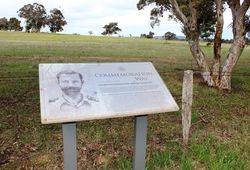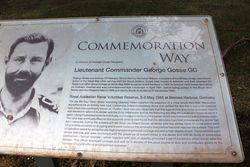
Lieutenant Commander George GossePrint Page 
George Gosse (1912-1964) was born in Western Australia and educated in Adelaide. He had been in the RAN for several years until 1933, and then rejoined during the war. Once while working underwater on a mine in Bremen harbour, he was lucky to escape when the detonator fired; fortunately, he had just managed to remove the primer. After the war he remained in the Royal Australian Navy Reserve until 1958. He was awarded the George Cross in 1946.
The service and sacrifice of Western Australia's Victoria Cross and George Cross recipients will be remembered in perpetuity with each recipient being commemorated at highway rest stops south of Perth. Veterans Minister Joe Francis said the project, similar to Remembrance Driveway on the Federal and Hume highways between Sydney and Canberra, would see plaques honouring WA's 17 Victoria Cross and two George Cross recipients placed at rest areas on highways leading to Albany.
"The rest stops will be on Albany Highway between Perth and Albany and along South Western Highway between Pinjarra and Kirup," Mr Francis said. The plaques will be installed at rest stops in chronological order, starting with the South Western Highway (Frederick Bell VC). Each will contain a short biography of the recipient and part of their citation as gazetted. "While the Victoria Cross is awarded for extreme gallantry in the face of the enemy, the George Cross - open to service personnel and civilians - was instituted to recognise extreme bravery that did not involve contact with the enemy. The series of plaques will be called Commemoration Way, and will be rolled out between ANZAC Day and Remembrance Day, 2016."
Media Statement, 20th April 2016.
Location
| Address: | Albany Highway , Rest Area, 24 kilometres south of Tunney Hall Road, Cranbrook, 6321 |
|---|---|
| State: | WA |
| Area: | AUS |
| GPS Coordinates: | Lat: -34.326186 Long: 117.526024 Note: GPS Coordinates are approximate. |
Details
| Monument Type: | Plaque |
|---|---|
| Monument Theme: | People |
| Sub-Theme: | Military |
| Actual Event Start Date: | 08-May-1945 |
| Actual Event End Date: | 09-May-1945 |
| Link: | http://adb.anu.edu.au/ |
Dedication
| Approx. Monument Dedication Date: | 2016 |
|---|
Commemoration Way
In honour of George Cross recipient
Lieutenant Commander George Gosse GC
George Gosse was born on 16 February 1912 in Harvey. His father William, a recipient of the Military Cross, was killed in action in the Great War while serving with the Royal Artillery. Gosse later moved to Adelaide and then attended the Royal Australian Naval College at Jervis Bay, NSW however he left the Navy in 1933. In October 1940 Gosse rejoined as an Ordinary Seaman and was commissioned Sub Lieutentant in April 1941, before being posted to the Royal Navy. Gosse was discharged in March 1946 and died in South Australia on 31 December 1964.
Royal Australian Naval Volunteer Reserve, 8-9 May 1945 at Bremen Harbour, Germany
"On the 8th May 1945, divers searching Ubersee Hafen reported the presence of a mine which from their description appeared to be an entirely new type. Lieutenant Gosse immediately dived and verified the fact that is was a GD pressure typre which was commonly known as "Oyster." As it was very necessary that this type of mine should be recovered intact it was decided to attempt to render safe the mine underwater and of the following day May 8th Lieutenant Gosse dived on it again.
Using improvised tools he eventually succeeded in removing the primer which was followed by a loud metallic crash. The mine was eventually lifted on the quayside when it was found that the detonator had fired immediately the primer had been removed. During the subsequent 10 days Lieutenant Gosse rendered safe two similar types of mines whcih were lying in close proximity to shipping and in each instance the detonator had fired before the mine reached the surface. This form of operation called for exceptionally high standard of personal courage and also a high degree of skill.
The conditions were always arduos and were combined with the presence of known mines in the docks and with all forms of underwater obstruction - human corpses - which together with lack of visibility produced a set of conditions which would deter the boldest. This officer displayed courage and zeal far in excess of the usual course of duty and contributed greatly to the success of a most difficult and important operation."






